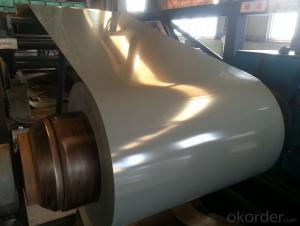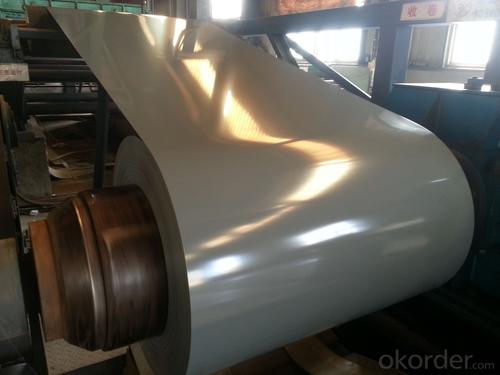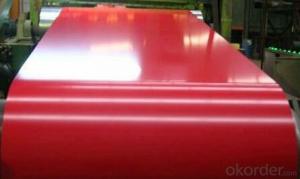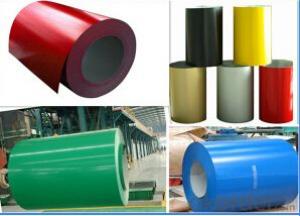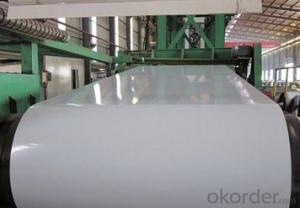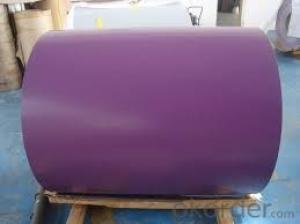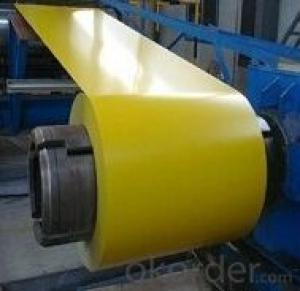Pre-painted galvanized steel coil PPGI PPGL COATED STEEL STOCK
- Loading Port:
- Tianjin
- Payment Terms:
- TT OR LC
- Min Order Qty:
- 20 m.t.
- Supply Capability:
- 10000 m.t./month
OKorder Service Pledge
OKorder Financial Service
You Might Also Like
PREPAINTED GALVANIZED STEEL COILS
ZINC COATING:60g/m2 (-/+10g/m2)
COLOR: ACCORDING TO COLOR SAMPLE.
TOP COATING:5+13 MICRON, BACK COATING:5-7 MICRON;
COIL WEIGHT:3-5 ton
STANDARD:JIS G 3312
STEEL GRADE:CGCC
COIL ID:508mm
1.THICKNESS:-0.02/+0.02mm; WIDTH:0/5mm.ZINC COATING:+/-10g/m2;
2.TOLERANCE:+/-10% WITH QUANTITIES AND AMOUNT.
3.PACKAGE:FULL PACKED WITH ANTI-DAMP PAPER,IRON SHEET OUTSIDE.
4.SHIPMENT: GOODS WILL BE DELIVERED WITHIN 20 DAYS AFTER RECEIVING ADVANCE PAYMENT
5.TERMS OF PAYMENT: 20% TT IN ADVANCE,80% AGAINST COPY OF B/L. OR LC AT SIGHT
6.THIRD PARTY INSPECTION: SGS, INTERTEK,COTECNA ,BV. ANY EXPENSE ON INSPECTION(SUCH AS SGS,INTERTEK...) SHALL BE ON BUYER'S ACCOUNT.
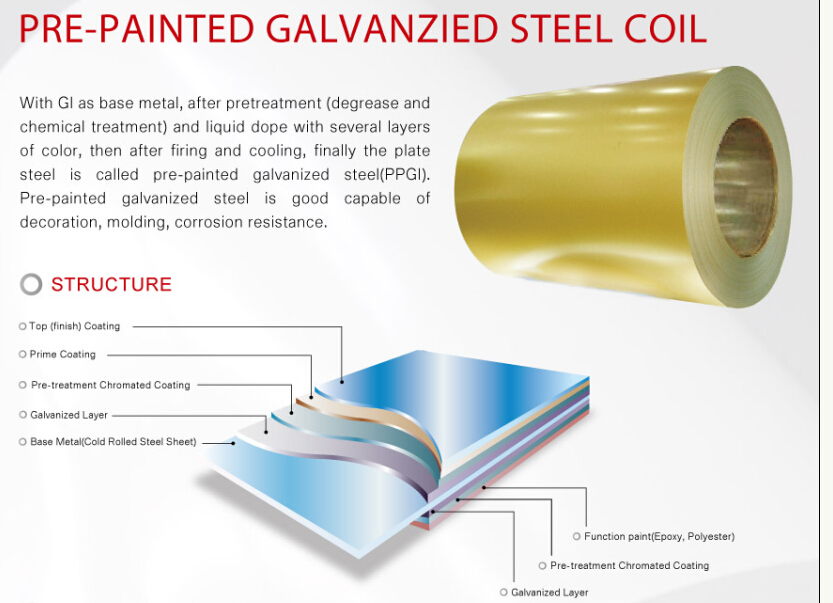

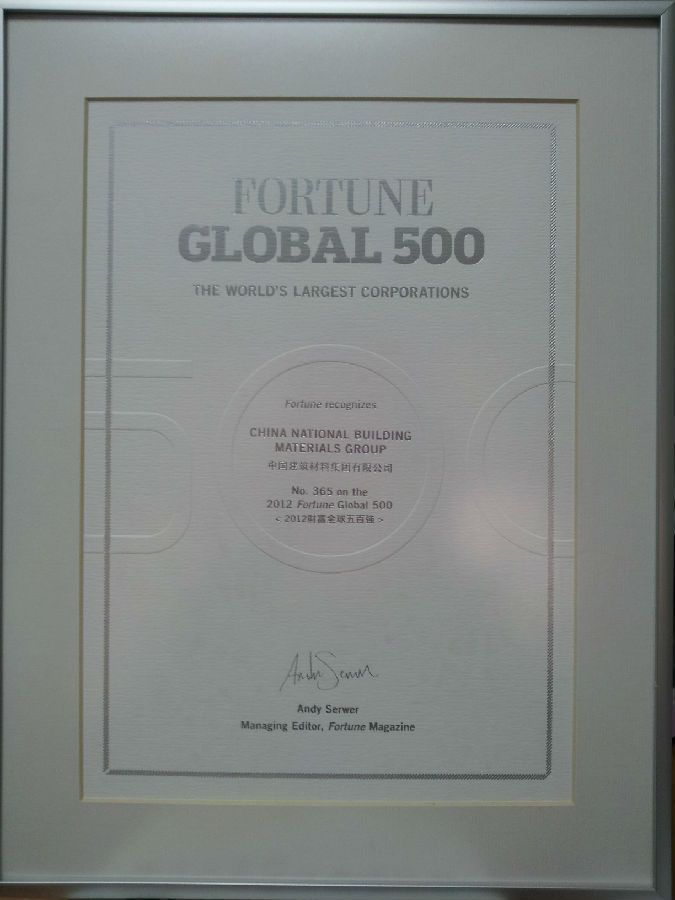
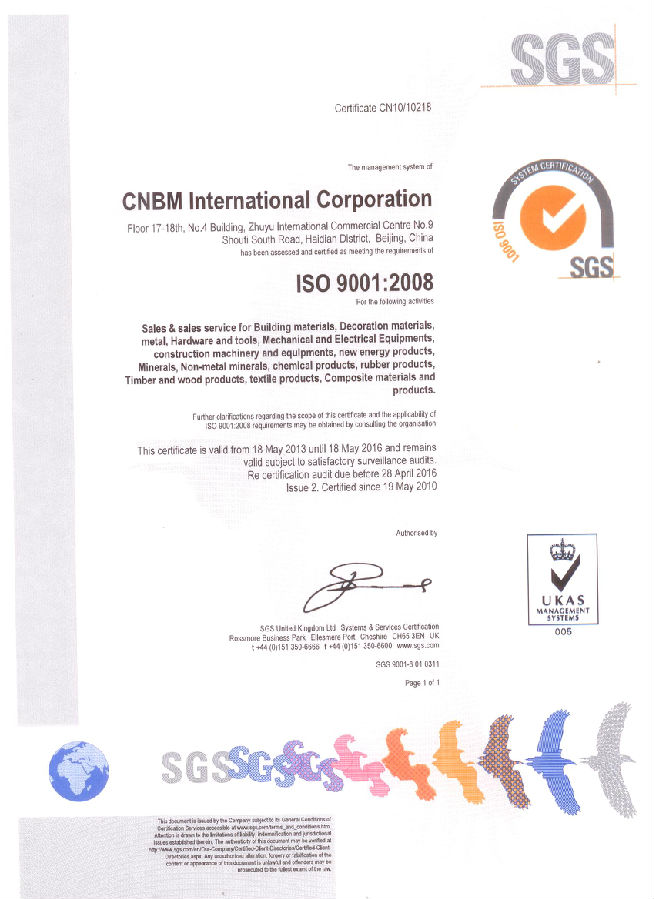
- Q: How is steel sustainable as a building material?How is wood sustainable as a building material?
- Wood as it comes from trees which are in nature.
- Q: What are the different methods of recoiling steel coils?
- There are several methods used for recoiling steel coils, depending on the specific requirements and characteristics of the material. Some of the common methods include: 1. Slitting: This method involves cutting the steel coil into narrower strips, which can then be recoiled. Slitting is typically done using rotary knives or circular saws, and it allows for precise width control. 2. Rewinding: This method involves unwinding the steel coil and then rewinding it onto a new coil mandrel. It is commonly used when the original coil needs to be resized, or when the coil has become damaged and needs to be reconditioned. 3. Recoiling with a tension control system: In this method, the steel coil is passed through a set of tension control rollers, which apply a controlled amount of tension to the material. This allows for a smooth and even recoiling process, minimizing the risk of coil distortion or damage. 4. Recoiling with a slitter head: This method combines the slitting and recoiling processes into a single operation. A slitter head is used to simultaneously cut the steel coil into narrower strips and rewind them onto separate coils. 5. Recoiling with a looping pit: In this method, the steel coil is fed through a looping pit, which allows for the accumulation of material as the coil is recoiled. This helps to maintain a consistent line speed and tension during the recoiling process. Each of these methods has its own advantages and is suitable for different applications. The choice of recoiling method depends on factors such as the desired coil dimensions, the material's thickness and strength, and the required level of precision and quality.
- Q: What are the quality control measures for steel coil production?
- To ensure that the final product meets the necessary standards and specifications, it is crucial to have quality control measures in place for steel coil production. Here are several commonly used measures in the process: 1. Inspection of Raw Materials: Prior to production, a thorough examination of the chemical composition, mechanical properties, and surface defects of materials like steel billets is conducted. This guarantees that only high-quality materials are used. 2. Control of Processes: Critical parameters such as temperature, rolling speed, tension, and lubrication are continuously monitored and controlled throughout production. Regular checks and adjustments are made to ensure that these parameters fall within the specified tolerances. 3. Assessment of Dimensions and Surfaces: Steel coils undergo stringent inspections to ensure they meet the required thickness, width, and length specifications. Surface defects like scratches, pits, or dents are meticulously examined and minimized to meet quality standards. 4. Mechanical Testing: Regular testing of mechanical properties like tensile strength, yield strength, elongation, and hardness is carried out. These tests are vital in ensuring that the steel coils possess the desired strength and performance characteristics. 5. Visual Inspection: Trained inspectors conduct thorough visual inspections to identify any visible defects or irregularities in the steel coils. Issues such as cracks, corrosion, or uneven surfaces are detected, and necessary actions are taken to rectify or reject faulty coils. 6. Non-Destructive Testing: Methods like ultrasonic testing, magnetic particle testing, or eddy current testing are often employed to detect internal defects like voids, inclusions, or discontinuities that may impact the quality of the steel coils. 7. Documentation and Traceability: Proper documentation and traceability of all quality control measures are maintained throughout the production process. This includes recording test results, inspection reports, and other relevant data to ensure transparency and accountability. 8. Continuous Improvement: Quality control measures in steel coil production are not static but constantly evolving. Regular audits, customer feedback, and analysis of process data are utilized to identify areas for improvement and implement corrective actions to enhance product quality. By implementing these quality control measures, steel coil manufacturers can guarantee that the final product meets the necessary specifications, performs reliably, and achieves customer satisfaction.
- Q: How many types of steel buildings are there?
- There are a number of designs which can be used to create different types of steel buildings as per the demands of the buyer or an investor. he various kinds of that can be constructed using steel are Homes, Hangars, Agriculture and Farm buildings for storage, Garages and Storage sheds, Open air sheds,, Barns, Arenas and stadiums, Automotive buildings with overhead doors and flexible framed openings, Religious buildings such as Churches and Temples, etc.
- Q: What are the common methods of storing steel coils in warehouses?
- There are several common methods for storing steel coils in warehouses, depending on the size and weight of the coils, as well as the available space and resources in the warehouse. Here are some of the most commonly used methods: 1. Block stacking: This method involves stacking the steel coils directly on top of each other, forming a block. The coils are typically aligned in rows and columns, with wood or rubber blocks placed between the layers to provide stability and prevent damage. 2. Racking systems: Racks are often used to store steel coils in warehouses. There are various types of racks, including cantilever racks, coil racks, and structural racks. These racks provide a structured system for organizing and storing the coils, allowing for easy access and efficient use of space. 3. Coil cradles: Coil cradles are a type of storage equipment specifically designed for steel coils. They consist of a series of cradles or saddles that securely hold the coils in place. These cradles can be stacked on top of each other to maximize vertical space utilization. 4. Coil pads: Coil pads are flat platforms made from materials such as wood, rubber, or foam. They are placed on the warehouse floor, and the steel coils are then stacked directly on top of them. Coil pads help to distribute the weight of the coils evenly and protect them from damage caused by contact with the floor. 5. Slit coil storage: Slit coils, which are narrower and lighter than full-size coils, can be stored using specialized storage systems. These systems often consist of racks or shelves equipped with dividers or separators to keep the coils organized and prevent them from unraveling. It is important to note that regardless of the storage method used, safety precautions should be followed when handling and storing steel coils in warehouses. This includes ensuring proper weight distribution, using appropriate lifting equipment, and adhering to industry-specific guidelines and regulations.
- Q: How do steel coils contribute to energy efficiency in appliances?
- Steel coils contribute to energy efficiency in appliances in several ways. Firstly, steel coils are commonly used in the heat exchangers of appliances such as refrigerators, air conditioners, and water heaters. These coils transfer heat efficiently, allowing appliances to cool or heat the desired space using less energy. By maximizing heat transfer, steel coils help appliances reach the desired temperature faster and maintain it with minimal energy consumption. Secondly, steel coils are often used in the heating elements of appliances like stoves and ovens. These coils provide direct heat to cook or bake food. Steel's excellent thermal conductivity ensures that the heat is evenly distributed, reducing cooking time and energy consumption. This allows appliances to work more efficiently, saving both time and energy. Furthermore, steel coils are durable and long-lasting, which contributes to energy efficiency in appliances. Appliances with steel coils are built to withstand high temperatures and frequent use. This means they require less maintenance and replacement, resulting in fewer resources being used to produce new appliances. By reducing waste and conserving resources, steel coils indirectly contribute to energy efficiency and sustainability. Lastly, steel is a recyclable material. When appliances reach the end of their life cycle, the steel coils can be recycled and used to produce new products. Recycling steel reduces the need for extracting raw materials and saves energy that would otherwise be required in the manufacturing process. This promotes energy efficiency and reduces the environmental impact of appliances. In conclusion, steel coils contribute to energy efficiency in appliances by optimizing heat transfer, reducing cooking time, promoting durability, and facilitating recycling. These factors collectively help appliances operate more efficiently, save energy, and contribute to a more sustainable future.
- Q: What is the type of stainless steel used in knifes.
- If your talking about a folding pocket knife, I think that it's basically six one way and a half dozen the other. I actually do prefer stainless for my pocket knives. I don't want to oil a knife to the degree I feel carbon requires, only to then stick it my pocket to attract dirt to the knife and oil to my pants. I'm the exact opposite on sheath knives though. I like 1095 carbon steel, plain edge sheath knives. I'll thrash on them HARD, and I rarely have major edge problems. Of course, I require them to be coated with some kind of powder coat or the like, because they can rust, but I do try and keep them clean and dry when in the sheath, so they won't pit the uncoated edge. My reasons for this sheath knife preference is multi-fold. First, these knives are simply affordable. I don't spend $80 dollars on a outdoors sheath knife. I use the tool too hard to want to spend more. I don't like the more traditional stainless steels such as AUS-8, 420HC, and 440C (not to mention the HORRENDOUS 440A) because I feel that the all else being equal, a stainless blade will bend before a carbon blade will break. I also think that carbon holds an edge at least as well, if not better, than traditional stainless, and it's much easier to hone. I don't know much about these new laminates, other than the very hard, but not so tough. They seem to be POSSIBLY too brittle for my use. That, combined with the fact that they cost a FORTUNE, means that I just won't be considering them.
- Q: What are the common applications of coated steel coils?
- Some common applications of coated steel coils include manufacturing of automotive parts, construction materials such as roofing and siding, appliances, and electrical equipment. They are also used in the production of household goods such as furniture, shelving, and storage racks. Additionally, coated steel coils find applications in the transportation industry for manufacturing trailers, shipping containers, and railway cars due to their durability and corrosion resistance.
- Q: How are steel coils inspected for chemical composition using spectroscopy?
- Spectroscopy techniques such as X-ray fluorescence (XRF) and laser-induced breakdown spectroscopy (LIBS) can be employed to examine the chemical makeup of steel coils. XRF involves directing an X-ray beam onto the surface of the steel coil, prompting the sample's atoms to emit distinct X-ray fluorescence radiation. By examining the energy and intensity of these emitted X-rays, one can determine the elemental composition of the steel. This method is both rapid and non-destructive, enabling swift and accurate assessment of the steel coil's chemical composition. On the other hand, LIBS entails focusing a laser beam onto the steel coil's surface, generating a high-temperature plasma. The plasma emits light, which is subsequently collected and analyzed using a spectrometer. This emitted light contains characteristic atomic and ionic emissions, allowing for the identification and quantification of various elements present in the steel. LIBS is also a non-destructive technique, providing real-time results and requiring minimal sample preparation. Both XRF and LIBS offer multiple benefits in terms of speed, non-destructiveness, and user-friendliness for inspecting the chemical composition of steel coils. These spectroscopic techniques play a vital role in quality control and assurance, ensuring that the steel meets the necessary specifications and standards for diverse industrial applications.
- Q: What is the current value of steel? Is it expected to increase in value?
- They'd never be worth much for their steel content, likely always less than face value. They might be worth a premium as coins, but not anything you'd call an investment.
Send your message to us
Pre-painted galvanized steel coil PPGI PPGL COATED STEEL STOCK
- Loading Port:
- Tianjin
- Payment Terms:
- TT OR LC
- Min Order Qty:
- 20 m.t.
- Supply Capability:
- 10000 m.t./month
OKorder Service Pledge
OKorder Financial Service
Similar products
Hot products
Hot Searches
Related keywords
